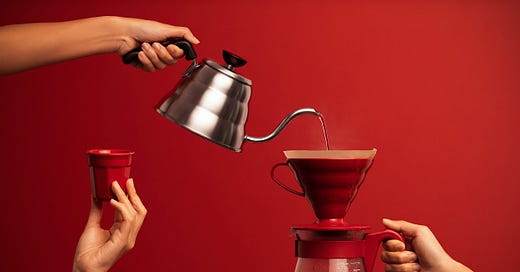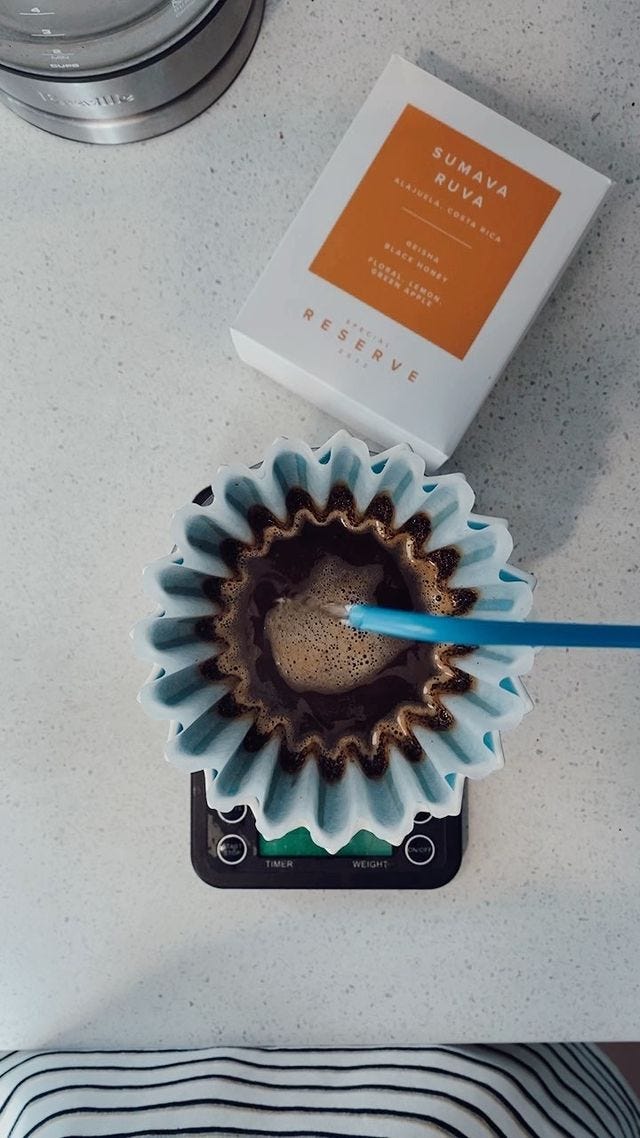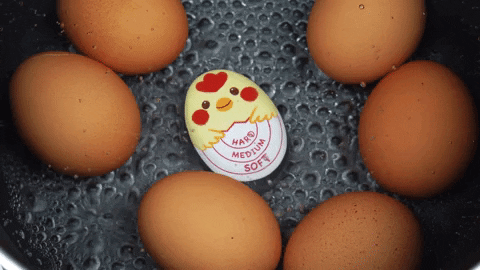Why does my coffee taste so sour/bitter and how do I make it better?
How many times a day do you ask yourself that question? Allow me to give you some tips on how to make it taste you are eating perfectly ripe strawberries and cream!
Keen on podcasts? Well, you are in luck, my friends. Click the link below to listen to this article as episode 2 of Coffee Break over on the Home Barista Podcast:
First and foremost let me be clear, that I'm going to be talking about this subject around pour-over vessels and this covers all of them from a conical shaped coffee dripper to flat bottom dripper.
Let us begin with dark roasts.
Now, hear me. I'm not saying that dark roasts are bad because they aren't, but they do have a preference when it comes to the brew method.
If you are using a dark roasted coffee or one that is specifically roasted for espresso, and you are brewing said coffee using any type of pour-over vessel. In my personal opinion, please stop!
This is the first hurdle that you are falling down. And one once again, in my personal opinion, that you will never be able to easily get over. Coffee that is roasted quite dark or specifically for espresso would express a lot more harsh and unpleasant flavours when brewed via a pour-over using hot water. What do I mean by hot water? Water that is straight off the boil.
Allow me to begin by giving you my top tips and what I recommend to anybody who is using a dark roasted coffee with a pour-over.
1: To begin with, you want to have less agitation of the coffee bed during the brewing stage. What do I mean by that? Great question. Allow me to open it up for you.
Most people will use a recipe that's either 15 grams of coffee followed by 250 grams of water with five X 50 grams pours, which the industry will call a pulse-pour recipe.
As previously mentioned dark roasted coffee has a lot more bitter flavours going on within the actual bean and the coffee itself, due to the way it has been roasted and most likely for the brewing equipment it is profiled for. With the addition of very hot water, you're going to dissolve a lot more of those harsh and bitter flavours which in filter coffee aren’t very pleasant.
On the flip side. If you enjoy using hot water and enjoy those harsh and bitter flavours within your coffee then I suggest you carry on but give this recipe a try:
15g of coffee, 250g of water with 2 pours.
So I would recommend using a recipe that uses two pours. So you're doing one pour for the Bloom followed by one long pour.
I tell people to do this because it's less agitation of the coffee bed. So you're not going to be drawing out a lot of those acidic and harsh flavours. Hopefully, you're going to end up with a sweeter brew that turns the dark roasted coffee into a more palatable cup of coffee for you to enjoy as a filter brew.
Water temperature.
Just to be clear I am in no way a scientist so what I am about to say has no scientific weight or backup. It is purely me and my everyday Breville kettle.
When it comes to dark roasted coffees - The higher the water temperature, the more harsh and unpleasant flavours you'll bring out of the coffee. And this goes back to what I was just saying about the agitation of the coffee bed. This is most common with dark roasts that are ground either too fine or are brewed with excessively hot water that dissolves a lot more of the grounds, resulting in a cup of coffee that is over-extracted.
This leads me beautifully onto grind size.
I've left this point till the end because it is an important one and there are lots of different variables involved. I will try my best just to touch on a couple that I know most people will see as a pain point.
Depending on what grinder you have at home, the particle sizes can vary in size, resulting in an uneven extraction of the coffee. Now, this is more common in hand grinders. I say that because hand grinders tend to be built around the conical Burr set, which is a very difficult set of burs to get a consistent grind with. I say that because the conical bears in a hand grinder are usually made from ceramic and wear down a lot quicker than a flat Burr or a proper Burr set that is within a more expensive grinder. If you do have a hand grinder and you're not able to invest or spend a bit more money on more of the top end of the hand grinder market, then I suggest investing in a sifter device that separates the grounds for you, allowing you to get more of what you need from the coffee grounds.
These come in many forms but the main one is a Kruve sifter. The Kruve comes with different metal screens that have thousands of holes in them in all different sizes, allowing you to screen your coffee grinds and end up with the ones that are the perfect size for the brew method you are using.
Think of it as a customs examination for your coffee before it can be allowed to proceed to the next stage of its journey haha.
Please do not be tempted to use a sieve you have at home that you also use for cooking. THIS WILL NOT WORK. It's completely different and what you'll end up doing is having a lot more of your coffee falling through the sieve, which will result in wastage.
So Sean what Burr Grinder should I buy?
To begin with, Burr grinders are expensive but the investment is well worth it and it will give you a much better coffee experience at home. Big call, I know but I can guarantee that your experience will be so much better.
I truly understand that these are expensive, but if you have invested in good gear and good coffee, then why not invest in a good grinder for your bench at home that will help you get the most out of the delicious coffee that you buy?
The way I view it is like buying a new pair of trainers. You look at a cheap pair say Asos own brand for $50 compared to my favourite pair of Nike React for $250 NZD. You know in the back of your mind that the Asos pair will give you a good time for roughly a year, you replace those trainers 5 times, when you could have just saved up and bought the Nike reacts and still have the same pair 5 years later. Bit of a drastic way of thinking about it, but what I am trying to get at is, that quality is better than quantity.
The main brands (in my opinion) to be looking for are Eureka and Niche. Also, not to mention they look super sexy on the bench and they're a fantastic conversation point for anybody that comes over coffee professional or non-coffee professional.
But, don’t take it from me as gospel truth. We live in the 21st century and we have an amazing free resource called Google and YouTube with many incredible creators who have spent hours creating videos to help you decide what your next purchase will be.
Let’s talk about dialling in a coffee.
A rule of thumb I have for dialling in coffee is to always start with a relatively fine grind. I do this as it is easier to make corrections by going coarser than it is to go finer. I say this because going from a finer grind to a coarser grind you will notice smaller differences almost instantly in the next cup of coffee you make.
Making notes about the brew and how it tastes is key.
Those notes are key because making small adjustments are sometimes easy to forget. So noting them down will help you land on the grind size you think is perfect for that particular coffee. The next best thing is that you can come back to them time and time again and it is a good sense of success as well for yourself to look back and to see how your palate is evolving and also how the coffee is evolving over time.
Now moving on to light/medium roasted coffees. A lot of what I've already said applies, but with a couple of differences, mostly in the processing, roasting and then taste of the coffee in the cup. Light to medium roasted coffees is all the rage at the moment for many reasons, one of those being that they lend themselves well to farmers who are keen to experiment with different processing methods.
You may have seen the name carbonic maceration and double fermentation floating around a bit lately. These are names of processing methods that in simple terms mean super wacky, fruity complex and high acidity tasting coffees. These coffees usually showcase heightened fruity and tropical flavours with a deep red wine complexity. With red fruits, think strawberries, cherry cranberries with tropical flavours, think pineapple, banana, mango and papaya.
But to the everyday consumer who brews a coffee at home that uses one of those two processes will usually comment that they don't enjoy this coffee as it is too acidic, bright and wacky for them.
This is because as humans we are used to experiencing those flavours in their natural form, which of course is food and those foods being cold (fruit). So when is a liquid that is hot with a heightened experience of all the senses due to it being hot, we get confused and comment we do not like it.
Light to medium roasted coffees is the best for experimenting with lower temperatures, bigger doses and more agitation as they tend to be more forgiving, better-roasted, cleaner and have a better balance between sweetness and acidity. But in saying that light to medium roasted coffees do come with their own challenges.
The challenge that you may face with a light to medium roasted coffee is that your brew is weak or watery. This happens when not enough of the coffee compounds have dissolved into the water. So in simple terms, it's under-extracted. The water has flowed through the bed of coffee too fast and hasn't had enough time to hang out with the coffee and extract what it needs.
The three main causes for this:
1) You are using too much water. (So you have used 300 grams of water for 15 grams of coffee instead of the usual 250 grams of water. Trust me, it makes a big difference).
2) Your grind was too coarse or the water you are using is not hot enough. (I tend to stick to 85-degree water and that is probably the lowest that I would go if I was doing any kind of experiment with different water temperatures).
Now if after all of these experiments your coffee still doesn't taste great, then this could actually be down to:
3) The coffee you are drinking and the way that it has been roasted.
Now from time to time. Not all coffee is fully developed when it has been dropped from the roaster and this is what we call underdeveloped coffee. You may have seen this term used in a couple of coffee blogs, a couple of social media posts or YouTube videos from people that talk about different roast levels and different coffee.
Underdeveloped coffee means the beans aren't roasted for long enough to develop the rich, full-bodied flavour of the bean. It's not that common, but it does happen, which leads me perfectly onto my last point.
Buy freshly roasted coffee from your local coffee roaster, not from the supermarket.
I know you've heard that so many times and so many people say it to you, but it makes a massive difference. When you buy freshly roasted coffee that is straight from the roaster it has been handled well, packaged well in the way that it needs to be, and it has not been sitting on a supermarket shelf for a couple of weeks or even, dare I say it, a couple of months. Ideally, the coffee that you buy would be no more than one to two weeks old, but up to a month is usually fine.
Darker roasted coffee ages a lot quicker than lightly roasted coffee, so if you are buying darker roasts, I would recommend placing it in the freezer in an airtight bag or container after about a week of ageing. What this will do is slow down the ageing process and will give you a bigger window of time to enjoy the coffee at its best.
Lightly roasted coffees you can tend to leave it out for longer and it will stay fresh and full-flavoured. That is why light to medium roasted coffees are perfect for any kind of pour-over or manual brew method.
So there we go, guys. I hope that this episode of Coffee Break here on substack has been helpful and gives you the confidence to experiment a little bit more with your coffee at home. Don't be scared to try new things with coffee. You never know what you'll find.
Thank you so much for reading.









Some amazing tips here! I used one today on a V60 brew I was trying out with a great bag of coffee from Rum Baba. I used the 5 pour method for some extra agitation and it bloody well slapped hard. Thanks for the pro tip!